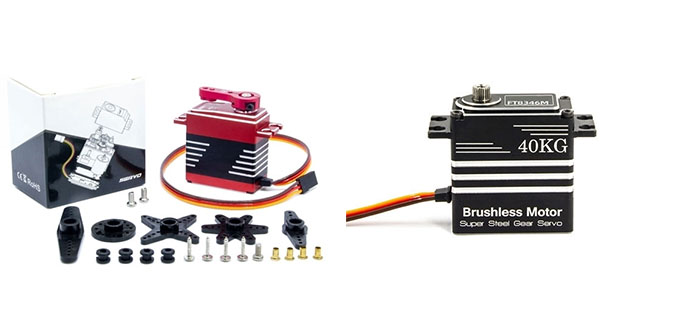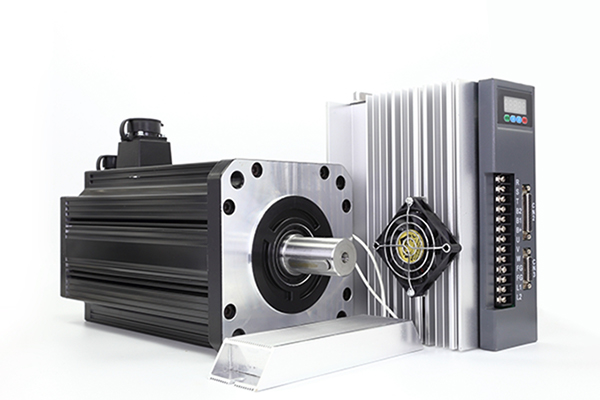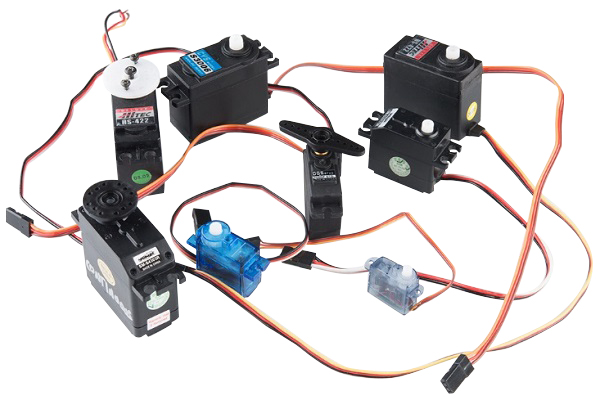What is a RC Servo?
RC Servos are very popular mechanisms in the world of RC models. No matter if this is a train model, or a car, or a boat, plane or helicopter, there must be at least one servo hidden somewhere within the constructions. RC Servos are used to convert electrical signal into polar or linear movement. A simple example is the steering system of an RC car. When signal is transmitted from the control to the car, this signal is decoded and sent to a servo. According to this signal, the servo will rotate it's drive shaft for some degrees, and this rotation is translated into wheel steering. The reason that makes those servos vary handy is that, they have a very easy (and universal) way of driving them with a simple PWM circuit, they can achieve from low to higher torques, enough to move almost everything needed in an RC model, they are very compact and reliable, and most of all, they come with very low prices according to their specifications.
The Anatomy of an RC Servo
The controller circuit: this is the "brain" of the servo. This circuit is responsible to read the user's input signal (pulses) and translate it into a motor revolution in such a way, that the drive shaft will be rotated to the desired position.
The feedback potentiometer: the shaft of the potentiometer is attached to the drive shaft of the servo. When the drive shaft rotates, so does the potentiometer. In that way, each and every rotation angle of the drive shaft, corresponds to a different resistance of the potentiometer. By reading the potentiometers' resistance, the controller is able to know the exact angle of the drive shaft of the servo.
The motor: this is usually a small high speed DC motor controlled by a H-bridge circuit attached to the servos' controller.
The gearbox: the gearbox will drive the motor's revolution to the drive shaft. Also, the rpm will be significantly reduced and the torque will be increased. The torque is one of the main characteristics of RC servos.
The drive shaft: when all of the above operate in perfect harmony, the drive shaft will be rotated with accuracy to the user's requested angle.
Application Scenario
There are different types of RC servo motors, including standard servos, continuous rotation servos, and linear servos, each designed for specific applications. Standard servos are used for controlling the position of a shaft within a limited range, while continuous rotation servos can rotate continuously in either direction, making them suitable for applications like driving wheels on a robot. Linear servos provide linear motion instead of rotational motion, which can be useful in certain scenarios.
 A typical radio control (RC) servo is shown above. Servos have a drive wheel (white in image above) that is controlled by a PWM coded signal. The wheel moves around 90-180 degrees in normal operation. Radio control servomotors are mass-produced for the hobby market and are therefore relatively inexpensive and consistently available. They are ideally suited for many small low-cost hobbyist and student robotics applications.
A typical radio control (RC) servo is shown above. Servos have a drive wheel (white in image above) that is controlled by a PWM coded signal. The wheel moves around 90-180 degrees in normal operation. Radio control servomotors are mass-produced for the hobby market and are therefore relatively inexpensive and consistently available. They are ideally suited for many small low-cost hobbyist and student robotics applications.
The wheel or control horn on the servo can be attached to a stiff wire push rod to move mechanical parts such as an airplane control surface as seen above, it can be attached to other parts or sensors to rotate them, or even a drive wheel can be attached to move a robot. A humanoid robot uses a servo to move each joint and can contain over twenty servos.
Types of RC servo motors
Standard Servo: these are the most common type of RC servo motors. They have a limited range of motion, typically around 180 degrees. Standard servos are used for applications where precise control of angular position is required, such as controlling the steering of a remote-controlled car or the ailerons of an airplane.
Continuous Rotation Servo: unlike standard servos, continuous rotation servos can rotate continuously in either direction. These servos are often used for driving wheels on a robot or for other applications where continuous motion is necessary.
Micro Servo: micro servos are smaller and lighter than standard servos. They are suitable for applications where space and weight are critical, such as in small RC airplanes or micro robots.
High-Torque Servo: high-torque servos are designed to provide greater force or torque. These servos are used in applications where the load on the servo is higher, such as in large-scale RC vehicles or robots carrying heavy payloads.
Digital Servo: digital servos use a digital control signal for more precise and faster movement. They often have higher resolution and can provide more accurate positioning compared to analog servos. Digital servos are commonly used in high-performance RC applications.
Brushless Servo: brushless servos use brushless motors instead of traditional brushed motors. They offer improved efficiency, higher power output, and longer lifespan compared to brushed servos. Brushless servos are often used in high-end or professional-grade RC applications.
Linear Servo: linear servos provide linear motion instead of rotational motion. They are suitable for applications where linear actuation is required, such as controlling the flaps on an aircraft or the landing gear of a vehicle.
The Anatomy of an RC Servo
The controller circuit: this is the "brain" of the servo. This circuit is responsible to read the user's input signal (pulses) and translate it into a motor revolution in such a way, that the drive shaft will be rotated to the desired position.
The feedback potentiometer: the shaft of the potentiometer is attached to the drive shaft of the servo. When the drive shaft rotates, so does the potentiometer. In that way, each and every rotation angle of the drive shaft, corresponds to a different resistance of the potentiometer. By reading the potentiometers' resistance, the controller is able to know the exact angle of the drive shaft of the servo.
The motor: this is usually a small high speed DC motor controlled by a H-bridge circuit attached to the servos' controller.
The gearbox: the gearbox will drive the motor's revolution to the drive shaft. Also, the rpm will be significantly reduced and the torque will be increased. The torque is one of the main characteristics of RC servos.
The drive shaft: when all of the above operate in perfect harmony, the drive shaft will be rotated with accuracy to the user's requested angle.
Application Scenario
There are different types of RC servo motors, including standard servos, continuous rotation servos, and linear servos, each designed for specific applications. Standard servos are used for controlling the position of a shaft within a limited range, while continuous rotation servos can rotate continuously in either direction, making them suitable for applications like driving wheels on a robot. Linear servos provide linear motion instead of rotational motion, which can be useful in certain scenarios.

The wheel or control horn on the servo can be attached to a stiff wire push rod to move mechanical parts such as an airplane control surface as seen above, it can be attached to other parts or sensors to rotate them, or even a drive wheel can be attached to move a robot. A humanoid robot uses a servo to move each joint and can contain over twenty servos.
Types of RC servo motors
Standard Servo: these are the most common type of RC servo motors. They have a limited range of motion, typically around 180 degrees. Standard servos are used for applications where precise control of angular position is required, such as controlling the steering of a remote-controlled car or the ailerons of an airplane.
Continuous Rotation Servo: unlike standard servos, continuous rotation servos can rotate continuously in either direction. These servos are often used for driving wheels on a robot or for other applications where continuous motion is necessary.
Micro Servo: micro servos are smaller and lighter than standard servos. They are suitable for applications where space and weight are critical, such as in small RC airplanes or micro robots.
High-Torque Servo: high-torque servos are designed to provide greater force or torque. These servos are used in applications where the load on the servo is higher, such as in large-scale RC vehicles or robots carrying heavy payloads.
Digital Servo: digital servos use a digital control signal for more precise and faster movement. They often have higher resolution and can provide more accurate positioning compared to analog servos. Digital servos are commonly used in high-performance RC applications.
Brushless Servo: brushless servos use brushless motors instead of traditional brushed motors. They offer improved efficiency, higher power output, and longer lifespan compared to brushed servos. Brushless servos are often used in high-end or professional-grade RC applications.
Linear Servo: linear servos provide linear motion instead of rotational motion. They are suitable for applications where linear actuation is required, such as controlling the flaps on an aircraft or the landing gear of a vehicle.
Post a Comment:
You may also like:

Category
Featured Articles
What is a Servo Motor?
 There are some special types of application of electrical motor where rotation of the motor is required for just a certain angle ...
There are some special types of application of electrical motor where rotation of the motor is required for just a certain angle ...
 There are some special types of application of electrical motor where rotation of the motor is required for just a certain angle ...
There are some special types of application of electrical motor where rotation of the motor is required for just a certain angle ...How to Select the Suitable Power ...
 It's important to consider the unique demands of a motion control application when selecting a power supply. During ...
It's important to consider the unique demands of a motion control application when selecting a power supply. During ...
 It's important to consider the unique demands of a motion control application when selecting a power supply. During ...
It's important to consider the unique demands of a motion control application when selecting a power supply. During ...What are the Types of Servo Motor?
 There are some special types of application of electrical motor where rotation of the motor is required for just a certain angle ...
There are some special types of application of electrical motor where rotation of the motor is required for just a certain angle ...
 There are some special types of application of electrical motor where rotation of the motor is required for just a certain angle ...
There are some special types of application of electrical motor where rotation of the motor is required for just a certain angle ...How to Maintain Servo Motor?
 Servo motors play a crucial role in various industries, serving as precision control devices in applications ranging from ...
Servo motors play a crucial role in various industries, serving as precision control devices in applications ranging from ...
 Servo motors play a crucial role in various industries, serving as precision control devices in applications ranging from ...
Servo motors play a crucial role in various industries, serving as precision control devices in applications ranging from ...How to Test Servo Motor?
 Servo motors are devices that convert electrical signals into mechanical motion and are widely used in industrial automation, ...
Servo motors are devices that convert electrical signals into mechanical motion and are widely used in industrial automation, ...
 Servo motors are devices that convert electrical signals into mechanical motion and are widely used in industrial automation, ...
Servo motors are devices that convert electrical signals into mechanical motion and are widely used in industrial automation, ...